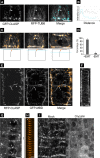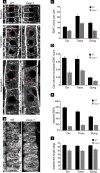CLASP promotes stable tethering of endoplasmic microtubules to the cell cortex to maintain cytoplasmic stability in Arabidopsis meristematic cells
- PMID: 29894477
- PMCID: PMC5997327
- DOI: 10.1371/journal.pone.0198521
CLASP promotes stable tethering of endoplasmic microtubules to the cell cortex to maintain cytoplasmic stability in Arabidopsis meristematic cells
Abstract
Following cytokinesis in plants, Endoplasmic MTs (EMTs) assemble on the nuclear surface, forming a radial network that extends out to the cell cortex, where they attach and incorporate into the cortical microtubule (CMT) array. We found that in these post-cytokinetic cells, the MT-associated protein CLASP is enriched at sites of EMT-cortex attachment, and is required for stable EMT tethering and growth into the cell cortex. Loss of EMT-cortex anchoring in clasp-1 mutants results in destabilized EMT arrays, and is accompanied by enhanced mobility of the cytoplasm, premature vacuolation, and precocious entry into cell elongation phase. Thus, EMTs appear to maintain cells in a meristematic state by providing a structural scaffold that stabilizes the cytoplasm to counteract actomyosin-based cytoplasmic streaming forces, thereby preventing premature establishment of a central vacuole and rapid cell elongation.
Conflict of interest statement
The authors have declared that no competing interests exist.
Figures





Similar articles
-
The Arabidopsis CLASP gene encodes a microtubule-associated protein involved in cell expansion and division.Plant Cell. 2007 Sep;19(9):2763-75. doi: 10.1105/tpc.107.053777. Epub 2007 Sep 14. Plant Cell. 2007. PMID: 17873093 Free PMC article.
-
"CLASPing" tungsten's effects on microtubules with "PINs".Plant Signal Behav. 2015;10(10):e1064572. doi: 10.1080/15592324.2015.1064572. Epub 2015 Aug 27. Plant Signal Behav. 2015. PMID: 26313814 Free PMC article.
-
The Microtubule-Associated Protein CLASP Is Translationally Regulated in Light-Dependent Root Apical Meristem Growth.Plant Physiol. 2020 Dec;184(4):2154-2167. doi: 10.1104/pp.20.00474. Epub 2020 Oct 6. Plant Physiol. 2020. PMID: 33023938 Free PMC article.
-
Microtubule organization and microtubule-associated proteins in plant cells.Int Rev Cell Mol Biol. 2014;312:1-52. doi: 10.1016/B978-0-12-800178-3.00001-4. Int Rev Cell Mol Biol. 2014. PMID: 25262237 Review.
-
Microtubules, MAPs and plant directional cell expansion.Trends Plant Sci. 2008 Jun;13(6):303-10. doi: 10.1016/j.tplants.2008.04.002. Epub 2008 May 6. Trends Plant Sci. 2008. PMID: 18467155 Review.
Cited by
-
Cortical microtubules oppose actomyosin-driven membrane ingression during C. elegans meiosis I polar body extrusion.bioRxiv [Preprint]. 2023 May 26:2023.05.26.542508. doi: 10.1101/2023.05.26.542508. bioRxiv. 2023. Update in: PLoS Genet. 2023 Oct 2;19(10):e1010984. doi: 10.1371/journal.pgen.1010984. PMID: 37292632 Free PMC article. Updated. Preprint.
-
A transient radial cortical microtubule array primes cell division in Arabidopsis.Proc Natl Acad Sci U S A. 2024 Jul 16;121(29):e2320470121. doi: 10.1073/pnas.2320470121. Epub 2024 Jul 11. Proc Natl Acad Sci U S A. 2024. PMID: 38990951 Free PMC article.
-
Genome-wide identification and characterization of the CLASP_N gene family in upland cotton (Gossypium hirsutum L.).PeerJ. 2022 Jan 3;10:e12733. doi: 10.7717/peerj.12733. eCollection 2022. PeerJ. 2022. PMID: 35036102 Free PMC article.
-
Phosphate promotes Arabidopsis root skewing and circumnutation through reorganisation of the microtubule cytoskeleton.New Phytol. 2024 Dec;244(6):2311-2325. doi: 10.1111/nph.20152. Epub 2024 Oct 3. New Phytol. 2024. PMID: 39360424 Free PMC article.
-
The importance of being edgy: cell geometric edges as an emerging polar domain in plant cells.J Microsc. 2020 Jun;278(3):123-131. doi: 10.1111/jmi.12847. Epub 2019 Nov 28. J Microsc. 2020. PMID: 31755561 Free PMC article. Review.
References
-
- Baskin TI. On the alignment of cellulose microfibrils by cortical microtubules: a review and a model. Protoplasma. 2001;215(1–4):150–171. - PubMed
-
- Chan J, Crowell E, Eder M, Calder G, Bunnewell S, Findlay K, et al. The rotation of cellulose synthase trajectories is microtubule dependent and influences the texture of epidermal cell walls in Arabidopsis hypocotyls. J Cell Sci. 2010;123(Pt 20):3490–3495. doi: 10.1242/jcs.074641 - DOI - PubMed
-
- Fujita M, Himmelspach R, Hocart CH, Williamson RE, Mansfield SD, Wasteneys GO. Cortical microtubules optimize cell-wall crystallinity to drive unidirectional growth in Arabidopsis. Plant J. 2011;66(6):915–928. doi: 10.1111/j.1365-313X.2011.04552.x - DOI - PubMed
-
- Paredez AR, Somerville CR, Ehrhardt DW. Visualization of cellulose synthase demonstrates functional association with microtubules. Science. 2006. June 9;312(5779):1491–5. doi: 10.1126/science.1126551 - DOI - PubMed
-
- Collings DA, Wasteneys GO. Actin microfilament and microtubule distribution patterns in the expanding root of Arabidopsis thaliana. Can J Bot. 2005. June;83(6):579–90.
Publication types
MeSH terms
Substances
LinkOut - more resources
Full Text Sources
Other Literature Sources
Molecular Biology Databases

